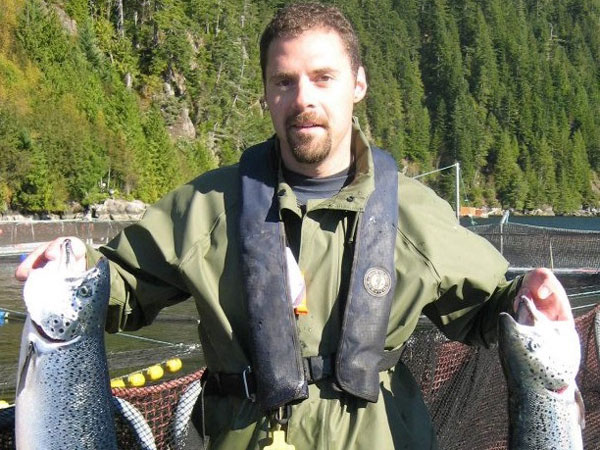
Spending time near water drew Alex Primus to a veterinary medical career focused on aquaculture.
Raising fish for food perfectly illustrates the One Health concept the College of Veterinary Medicine has promoted for many years to describe the interdependence of animal, human and environmental health, says Alex Primus, assistant professor in the Department of Veterinary Population Medicine.
“Fish is a very heathy source of protein and when farmed responsibly can be produced in a very environmentally sustainable manner. Some aquaculture practices, however, can negatively impact the environment which ultimately has public health implications,” Primus says. “One has to take many factors into consideration when developing a fish health management plan in aquaculture, perhaps even more than with other agriculture systems.”
Primus, who joined the University faculty in 2016, investigates infectious fish diseases in both wild and farm-raised fish. He’s particularly interested in fish health and disease prevention in the indoor aquaculture of high-value species such as Arctic char, trout and shrimp that are now finding a foothold in Minnesota.
“Several groups across the US are now raising food fish in recirculating systems, but it is still unclear how profitable such an enterprise can be,” he says.
Primus grew up in Edina, got his BA at Carleton and his PhD at the University of Texas at Austin, where he studied embryology in marine invertebrates. After conducting a postdoctoral fellowship at Duke University, he came to the University of Minnesota for veterinary school. “After college I spent a lot of time by the water and became very interested in the unique dynamics of aquatic systems,” he says. “When I got to vet school I knew I wanted to work on fish health.”
After graduation, he worked for a private company on Prince Edward Island, Canada, developing vaccines to prevent infections in farm-raised fish. “It was a great professional experience,” he says. “I learned a lot about international aquaculture operations, vaccine development, and how R&D is conducted in the private sector.”
He returned to the Minnesota faculty to teach and conduct research. He also has connections to the Veterinary Diagnostic Laboratory and University Extension. He often consults with professionals in Minnesota about aquaculture, fish health and disease prevention strategies in aquatic environments.
“One of the things that really drew me to the field of fish health was my desire to contribute to the continued development and use of sustainable aquaculture practices. A lot of the sustainability issues in aquaculture are related to the appropriate management of infectious disease, which absolutely includes disease prevention,” he says. “One example of preventative medicine where there is room for growth in aquaculture is the use of vaccines. Preventing disease with vaccines has several benefits which include minimizing the need for antimicrobials, minimizing the risk of transferring pathogens to wild fish, and improving the welfare of the fish generally.”
He is currently involved with two aquaculture-related CAHFS projects. He helped organize a day-long symposium on aquaponics, and he is involved with an aquatic epidemiology project in Chile to identify improved management strategies for salmon culture in that country.